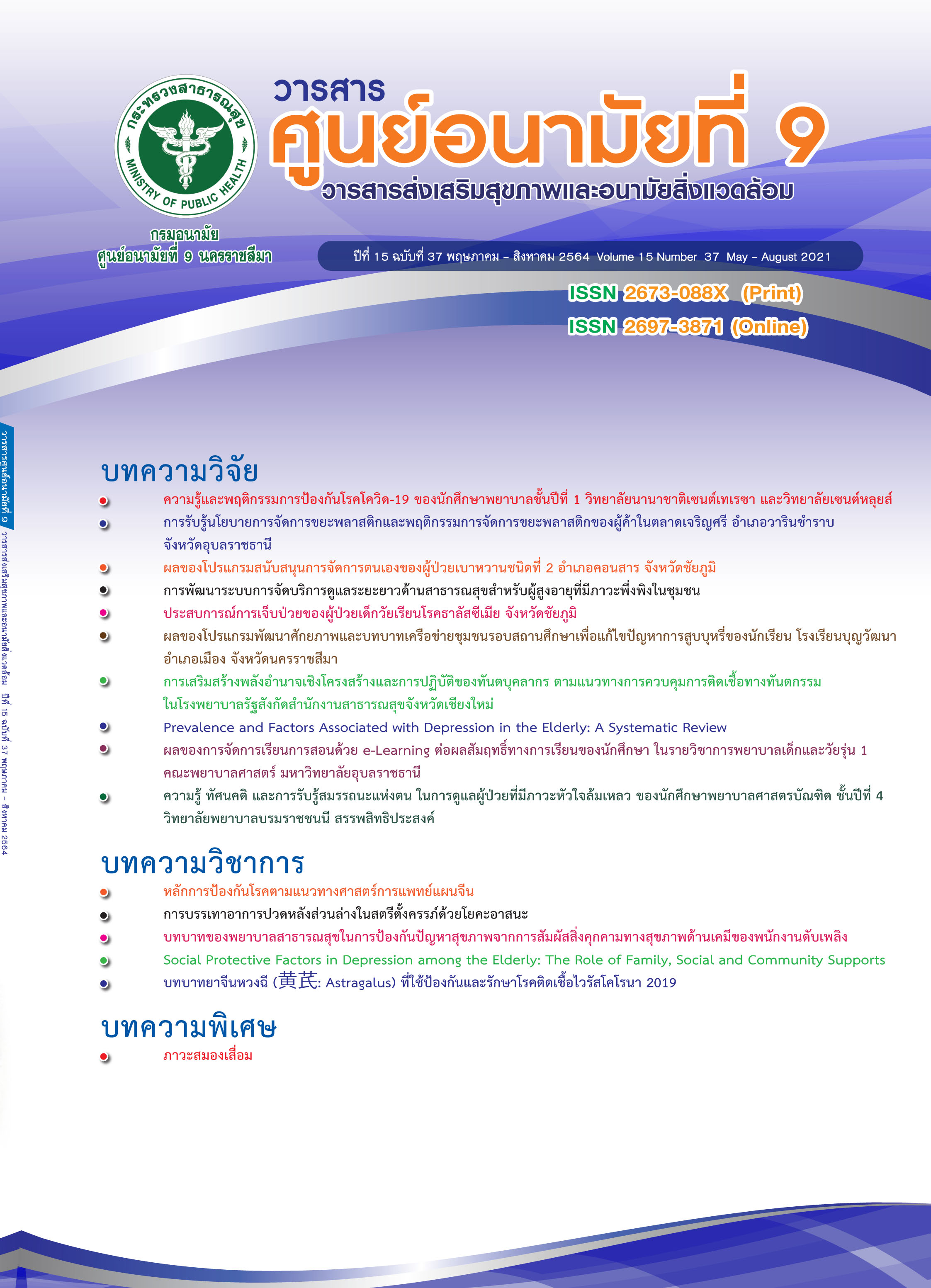การเสริมสร้างพลังอำนาจเชิงโครงสร้างและการปฏิบัติของทันตบุคลากร ตามแนวทางการควบคุมการติดเชื้อทางทันตกรรม ในโรงพยาบาลรัฐสังกัดสำนักงานสาธารณสุขจังหวัดเชียงใหม่
คำสำคัญ:
การเสริมสร้างพลังอำนาจเชิงโครงสร้าง, การปฏิบัติตามแนวทางการควบคุมการติดเชื้อ, งานทันตกรรมบทคัดย่อ
การวิจัยเชิงสำรวจนี้มีวัตถุประสงค์เพื่อศึกษา (1) การได้รับการเสริมสร้างพลังอำนาจเชิงโครงสร้าง และการปฏิบัติตามแนวทางการควบคุมการติดเชื้อทางทันตกรรม และ (2) ความสัมพันธ์ระหว่างเพศ ตำแหน่งงาน ประสบการณ์การทำงาน และการได้รับการเสริมสร้างพลังอำนาจเชิงโครงสร้าง กับการปฏิบัติตามแนวทางการควบคุมการติดเชื้อทางทันตกรรม ประชากรคือ ทันตบุคลากรในโรงพยาบาลรัฐ สังกัดสำนักงานสาธารณสุขจังหวัดเชียงใหม่จำนวน 348 คน กลุ่มตัวอย่างจำนวน 184 คน ได้จากการสุ่มแบบจัดชั้นตามตำแหน่งงาน เก็บข้อมูลด้วยแบบสอบถามตั้งแต่ 1 เมษายน ถึง 31 พฤษภาคม พ.ศ. 2563 สถิติที่ใช้ในการวิเคราะห์ข้อมูล คือ ร้อยละ ค่าเฉลี่ย ส่วนเบี่ยงเบนมาตรฐาน และการวิเคราะห์ถดถอยพหุคูณ
ผลการศึกษาพบว่า (1) ทันตบุคลากรได้รับการเสริมสร้างพลังอำนาจเชิงโครงสร้าง และปฏิบัติตามแนวทางการควบคุมการติดเชื้อทางทันตกรรมในระดับสูง และ (2) เมื่อควบคุมตัวแปรอื่น ๆ ให้เป็นค่าคงที่ พบว่า เพศ ประสบการณ์การทำงาน และการได้รับการเสริมสร้างพลังอำนาจเชิงโครงสร้าง มีความสัมพันธ์กับการปฏิบัติตามแนวทางการควบคุมการติดเชื้อทางทันตกรรมอย่างมีนัยสำคัญทางสถิติ (p-value<0.05) และใช้พยากรณ์พฤติกรรมการปฏิบัติตามแนวทางการควบคุมการติดเชื้อทางทันตกรรมได้ โดยมีประสิทธิภาพการพยากรณ์ 16.1% นั่นคือตัวพยากรณ์ทั้ง 3 ตัว ร่วมกันอธิบายความแปรปรวนของการปฏิบัติตามแนวทางการควบคุมการติดเชื้อทางทันตกรรมได้ร้อยละ 16.1 ปัจจัยที่มีอิทธิพลต่อการปฏิบัติตามแนวทางการควบคุมการติดเชื้อทางทันตกรรมสูงที่สุดตามลำดับ คือ การได้รับการเสริมสร้างพลังอำนาจเชิงโครงสร้าง เพศชาย และประสบการณ์ทำงาน (β=0.381, -0.173 และ 0.144) การศึกษานี้ไม่พบว่าการปฏิบัติตามแนวทางการควบคุมการติดเชื้อทางทันตกรรมมีความสัมพันธ์กับตำแหน่งงาน โดยสรุปการได้รับการเสริมสร้างพลังอำนาจเชิงโครงสร้างและประสบการณ์ทำงานมีอิทธิพลเชิงบวก แต่ลักษณะเพศชายมีอิทธิพลเชิงลบต่อการปฏิบัติตามแนวทางการควบคุมการติดเชื้อทางทันตกรรม
เอกสารอ้างอิง
Singh A, Purohit BM, Bhambal A, Saxena S, Gupta A. Knowledge, attitudes, and practice regarding infection control measures among dental students in Central India. Journal of dental education. 2011;75(3):421-7.
Laheij AM, Kistler JO, Belibasakis GN, Valimaa H, de Soet JJ. Healthcare-associated viral and bacterial infections in dentistry. Journal of oral microbiology. 2012;4.
Cadmus SI, Okoje VN, Taiwo BO, van Soolingen D. Exposure of dentists to Mycobacterium tuberculosis, Ibadan, Nigeria. Emerging infectious diseases. 2010;16(9):1479-81.
CDC. Summary of Infection Prevention Practices in Dental Settings: Basic Expectations for Safe Care Atlanta, GA: US Department of Health and Human Services, Centers for Disease Control and Prevention, National Center for Chronic Disease Prevention and Health Promotion, Division of Oral Health; March 2016.2016.
ทันตแพทยสภา. แนวทางปฏิบัติเพื่อความปลอดภัยทางทันตกรรม Dental Safety Goals & Guidelines 2015. นนทบุรี: ทันตแพทยสภา; 2015.
Puttaiah R, Miller K, Bedi DR, Shetty S, Almas K, Tse E, et al. Comparison of knowledge, attitudes and practice of dental safety from eight countries at the turn of the century. The journal of contemporary dental practice. 2011;12(1):1-7.
Myers R, Larson E, Cheng B, Schwartz A, Da Silva K, Kunzel C. Hand hygiene among general practice dentists: a survey of knowledge, attitudes and practices. Journal of the American Dental Association (1939). 2008;139(7):948-57.
Petti S. Advance in Infection Epidemiology and Control in Dental Healthcare Settings. Acta Stomatological Naisssi. 2013;29(67):1224-9.
Lastinger A, Gomez K, Manegold E, Khakoo R. Use of a patient empowerment tool for hand hygiene. American journal of infection control. 2017;45(8):824-9.
Yoon J-M, Sung M-H. The Relationship between Empowerment and Performance of Infection Control by Emergency Department Nurses. Journal of Korean Academy of Fundamentals of Nursing. 2009;16(4):412-20.
Gibson JL, Ivancevich JM, Donnelly JH, Konopaske R. Organization: Behavior, Structure, Processes. 2th, editor. New York: McGraw - Hill; 1992.
อรพรรณ ลือบุญธวัชชัย. การเสริมสร้างพลังอำนาจกับพยาบาลสุขภาพจิตและจิตเวช. วารสารการพยาบาลจิตเวชและสุขภาพจิต. 2541;12(มกราคม-ธันวาคม):14-24.
Kanter RM. Power failure in management circuits. Harvard Business Review. 1979;4:65-75.
Laschinger HK, Gilbert S, Smith LM, Leslie K. Towards a comprehensive theory of nurse/patient empowerment: applying Kanter's empowerment theory to patient care. Journal of nursing management. 2010;18(1):4-13.
Alejandro O-R, Yolanda B-A. Empowering Employees: Structural Empowerment as Antecedent of Job Satisfaction in University Settings. Psychological Thought. 2014;7(1):28-36.
Haridi HK, Al-Ammar AS, Al-Mansour MI. Compliance with infection control standard precautions guidelines: a survey among dental healthcare workers in Hail Region, Saudi Arabia. J Infect Prev. 2016;17(6):268-76.
Dagher J, Sfeir C, Abdallah A, Majzoub Z. Infection Control Measures in Private Dental Clinics in Lebanon. Int J Dent. 2017;2017:5057248.
Ebrahimi M, Ajami BM, Rezaeian A. Longer years of practice and higher education levels promote infection control in Iranian dental practitioners. Iran Red Crescent Med J. 2012;14(7):422-9.
Krejcie RV, Morgan DW. Determining Sample Size for Research Activities. Educational and Psychological Measurement. 1970;30(3):607-10.
Babbie E. The practice of Social research. 11th Edition. Belmont CA: Thomson Wadsworth; 2007.
ชูใจ คูหารัตนชัย. สถิติเบื้องต้น. กรุงเทพฯ: ภาควิชาสถิติประยุกต์ มหาวิทยาลัยเทคโนโลยีมหานคร; 2542.
ปาจรีย์ อ่อนสอาด. การสื่อสารองค์กรสุขภาพ: ชมรมคนรักษ์ตับศูนย์โรคตับ โรงพยาบาลจุฬาลงกรณ์. สุทธิปริทัศน์ 2559;30(94):1-14.
บุญเรือน ทองทิพย์, ศรุดา สมพอง. การบริหารภาครัฐโดยใช้เครือข่ายทางสังคมเพื่อแก้ปัญหาการขาดแคลนงบประมาณของกระทรวงสาธารณสุข. วารสารมหาจุฬานาครทรรศน์. 2562;6(4):1854-71.
ศุภชัย ยาณะเรือง, อนุวัฒน์ วัฒนพิชญากูล, ภคิน ไชยช่วย. ปัญหาความก้าวหน้าและการประกอบวิชาชีพของทันตาภิบาล. วารสารทันตาภิบาล 2561;29(1):49-56.
Garland KV. A survey of United States dental hygienists' knowledge, attitudes, and practices with infection control guidelines. Journal of dental hygiene. 2013;87(3):140-51.
Weber DJ, Rutala WA, Miller MB, Huslage K, Sickbert-Bennett E. Role of hospital surfaces in the transmission of emerging health care-associated pathogens: norovirus, Clostridium difficile, and Acinetobacter species. American journal of infection control. 2010;38(5 Suppl 1):S25-33.
Meng L, Hua F, Bian Z. Coronavirus Disease 2019 (COVID-19): Emerging and Future Challenges for Dental and Oral Medicine. J Dent Res. 2020;99(5):481-7.
Abreu MH, Lopes-Terra MC, Braz LF, Rimulo AL, Paiva SM, Pordeus IA. Attitudes and behavior of dental students concerning infection control rules: a study with a10-year interval. Braz Dent J. 2009;20(3):221-5.
CDC. CDC’s Guidelines for Infection Control in Dental Health-Care Settings -2003. Atlanta, GA: US Department of Health and Human Services, Centers for Disease Control and Prevention, National Center for Chronic Disease Prevention and Health Promotion, Division of Oral Health; 2003.
Alharbi A, Alharbi S, Alqaidi S. Guidelines for dental care provision during the COVID-19 pandemic. Saudi Dent J. 2020;32(4):181-186.
อภิญญา ยุทธชาวิทย์, วีระชาติ ยุทธชาวิทย์. ปัจจัยที่มีความสัมพันธ์กับพฤติกรรมขบวนการติดเชื้อในคลินิกทันตกรรมของนักศึกษาหลักสูตรสาธารณสุขศาสตรบัณฑิต สาขาวิชาทันตสาธารณสุข วิทยาลัยสาธารณสุขสิรินธร จังหวัดขอนแก่น. วารสารทันตาภิบาล. 2560;28(1):87-100.
Askarian M, Assadian O. Infection control practices among dental professionals in Shiraz Dentistry School, Iran. Archives of Iranian medicine. 2009;12(1):48-51.
McCarthy GM, MacDonald JK. Gender differences in characteristics, infection control practices, knowledge and attitudes related to HIV among Ontario dentists. Community dentistry and oral epidemiology. 1996;24(6):412-5.
N Osazuwa-Peters, CC Azodo, AO Ehizele, ON Obuekwe. Gender differences in characteristics, occupational exposure, and infection control practices among dental professionals in Edo State, Nigeria. South Afr J Epidemiol Infect. 2012;27(2):61-5.
Geisler E, Wickramasinghe N. Principles of knowlwdge management. Theory, Practice, and cases. New York: M.E. Sharpe; 2009.
Laschinger HK. A theoretical approach to studying work empowerment in nursing: a review of studies testing Kanter's theory of structural power in organizations. Nursing administration quarterly. 1996;20(2):25-41.
ดาวน์โหลด
เผยแพร่แล้ว
รูปแบบการอ้างอิง
ฉบับ
ประเภทบทความ
สัญญาอนุญาต
ลิขสิทธิ์ (c) 2021 วารสารศูนย์อนามัยที่ 9 : วารสารส่งเสริมสุขภาพและอนามัยสิ่งแวดล้อม

อนุญาตภายใต้เงื่อนไข Creative Commons Attribution-NonCommercial-NoDerivatives 4.0 International License.
บทความหรือข้อคิดเห็นใด ๆ ที่ประกฎในวารสารศูนย์อนามัยที่ 9 เป็นความคิดเห็นของผู้เขียน บรรณาธิการ คณะผู้จัดทำ และศูนย์อนามัยที่ 9 นครราชสีมา (เจ้าของ) ไม่จำเป็นต้องเห็นด้วย ผู้เขียนต้องรับผิดชอบต่อบทความของตนเอง
ผลการพิจารณาของกองบรรณาธิการและผู้ทรงคุณวุฒิถือเป็นที่สิ้นสุด คณะบรรณาธิการวารสารฯ ขอสงวนสิทธิ์ในการตรวจแก้ไขข้อความให้ถูกต้องตามหลักภาษาและมีความเหมาะสม
กองบรรณาธิการวารสารฯ ขอสงวนสิทธิ์มิให้นำเนื้อหาใด ๆ ของบทความ หรือข้อคิดเห็นใด ๆ ของผลการประเมินบทความในวารสารฯ ไปเผยแพร่ก่อนได้รับอนุญาตจากกองบรรณาธิการ อย่างเป็นลายลักษณ์อักษร และผลงานที่ได้รับการตีพิมพ์ถือเป็นลิขสิทธิ์ของวารสารศูนย์อนามัยที่ 9


